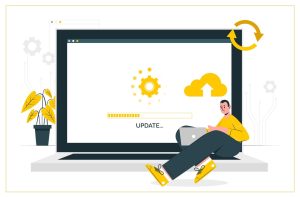Multi Cloud Migration & Operations – No EAM? No party!
The large cloud providers and user companies have come closer – enterprise workloads are increasingly finding their home in the hybrid & public cloud
The way to get there is to migrate and modernize the applications, but that’s not as easy as it sounds
Before, during and after the cloud transformation phase, companies need as much information about their applications as possible in order not to make mistakes – this is where Enterprise Architecture Management comes into play
No matter whether Google, AWS or Microsoft – the public cloud providers have been on the enterprise train for some time. The companies needed something to accept this initiative as a big gesture from the providers, especially in the German-speaking countries. Due to the numerous developments of cloud providers in the direction of hybrid clouds, be it partnerships, their own on-premise products or machine learning and cloud management tools, after a long start-up phase, companies finally have the opportunity to use cloud architectures as the de facto standard and foundation for their enterprise IT.
Application modernization for cloud butter for fish
For this reason, the cloud migration fever has flared up in numerous companies. The IT department not only has the opportunity to finally lift applications into the cloud for their lifecycles and other legacy applications and explore performance and efficiency advantages, but can also act as a translator and important middleman for digital applications.
Until recently, cloud computing was hardly a game for IT and application departments in many companies. Rather, the digital departments have built their cloud architectures past IT – not always successfully.
Now it is time, also because the tools and maturity of the cloud are available, that the companies move back to the cloud in an orderly manner. This can also be seen in the cloud trend barometer for German companies. In a recent study by Crisp, 83 percent of company’s state that they will soon be moving a majority of their applications to the cloud. For this purpose, every third company is in a large-scale transformation project or is entering into one.
Ready, set, go – Nothing happens without the right data
So far, the project of the users sounds very nice & good. There seems to be a clear commitment towards the cloud, positive signs and, despite ongoing economic fluctuations, sufficient budgets (in order to ultimately become more cost-effective).
But how does this move work in practice? Andy Jassy, CEO of AWS used a very striking example in his keynote at this year’s re: invent in Las Vegas. If a move is pending, you also muck out. Old furniture that is no longer needed will be replaced by new one, others will be reprocessed to shine in the new place in the future.
The same principle applies to cloud migration. Workloads are transferred to the cloud via Lift & Shift almost exactly as in the on premise architecture. They can also be modernized by either renewing or replacing individual components such as the operating system, individual tools or the databases. It is also conceivable that applications will be replaced and come to life as “built new cloud native” applications.
In order to find out which strategy is the right one for which application, a lot of information about the respective application is required. Load behavior, APIs & interfaces, release cycles, downtimes, management tooling etc. play a significant role in making the right decision.
This information is not always present, especially in confusing application landscapes of a few hundred or even thousands of applications.
For this reason, enterprise architecture management platforms such as LeanIX are currently experiencing an enormous boom. They access the applications and can automatically evaluate and visualize a large part of the systems. In this way, applications with the right information can be grouped and prepared for migration.
Enterprise Architecture Management à la LeanIX – Cloud Native Ops for the cool kids
But not only the strategy selection for the migration towards the cloud, but also the ongoing analysis in the cloud are important for the companies. Validating migrated (and new) applications in the cloud is particularly important for further development. On the one hand, companies, IT departments or partner service providers can draw new conclusions from the operational data for future migrations, on the other hand, they can also further optimize existing applications in the cloud.
To ensure this, LeanIX, together with the data intelligence provider Cloudockit, presented the LeanIX Cloud Native Suite . This can draw important information from applications on the leading public clouds in order to show potential for improvement in terms of costs, performance, integration, security and governance.
Cloud computing 2020 – optimization as far as the eye can see
Regardless of whether it is enterprise architecture management, cloud providers or service providers: One major trend for the digital cloud infrastructure 2020 will be to optimize it. Numerous announcements and observations confirm that companies use cloud resources on a large scale, now it is time to make them even more efficient before looking for an alternative.
This article is written by the Maximilian Hille which is a senior analyst and practice lead at Folio3 best food Safety Software development company. As a Cloud Practice Lead, he leads all research and consulting activities on the topics of cloud architecture, cloud native technologies, managed cloud services, digital workplace and mobility.





